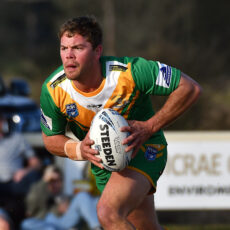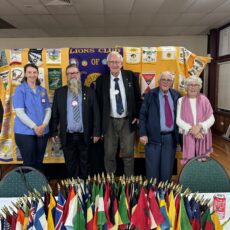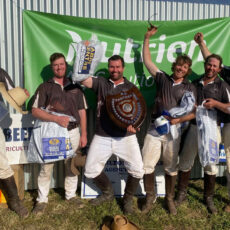Some people dread birthdays and turning a year older, but cancer survivor Katrina Richards described celebrating her 48th birthday on March 3 this year as “a privilege”.
“It’s extremely special because I didn’t think I was going to see 43,” said the Narrabri resident.
“I had a five per cent chance of coming home.
“Before I went to Sydney, I had to make sure I had my will done, I had a living guardianship for my daughter because her father had passed away a few years ago and I had to make sure that she was going to be taken care of.
“I’d even arranged my funeral.
“As I walked out the door, I looked around my house and I thought – well I may not see it all again.
“It was pretty hard for my partner too; he was driving me down there wondering if I would be coming home.
“It’s not just the person with cancer who suffers, it’s the whole family.
“My mum and dad pretty much put their lives on hold for years to help me.”
In 2015, Katrina Richards was diagnosed with Sézary syndrome: an aggressive and rare form of a type of blood cancer called sub cutaneous T-cell lymphoma.
Sub cutaneous T-cell lymphomas occur when certain white blood cells, called T cells, become cancerous; these cancers characteristically affect the skin, and can impact lymph nodes.
Since 2010, Katrina had been suffering symptoms such as a burning itch to full-body rashes, however, she said she was misdiagnosed with the autoimmune disease psoriasis.
“I’d been walking around for five years with cancer and didn’t know,” explained Katrina.
“And then, here I am, I have stage four blood cancer, there’s nothing after stage five.
“My skin was in a meltdown, I was doing bleach baths three times a week, I was doing wet wraps three times a day, I couldn’t walk with the splits on my feet, I was wearing cotton gloves because I couldn’t open up my hands, I couldn’t drive because my reflexes were just shot,” she said.
“I was shocked when I got the diagnosis, I was upset but it was bittersweet because in the end I finally find out what was wrong.
“It took my doctor 10 minutes before he could even speak and tell me that I had cancer – he was almost in tears because I’d been seeing him for three years and by that stage, I’d only just gone 40 so I was still youngish.”
It was a chance meeting and circumstance with a visiting specialist that helped Katrina receive the correct diagnosis.
“I was referred to a rheumatologist who was visiting Narrabri because they said I had psoriasis, and thought I had arthritis through psoriasis.”
Katrina said “by a fluke chance” the rheumatologist’s wife had been researching the stage of blood cancer she was eventually diagnosed with.
“Because his wife was researching it and him being a doctor, he was obviously interested in what his wife was doing.
“He looked at my skin and he was like, ‘this doesn’t look like what psoriasis normally looks like’.”
This “fluke chance” finally put Katrina on the right track to obtaining the right diagnosis.
The Narrabri mother and grandmother is sharing her story to call for action to fix the gaps in our healthcare system, especially the disparity between country and city areas, so future generations don’t have to suffer like she did: navigating a complicated medical system, footing expensive bills, and struggling to get the diagnosis and care she desperately needed.
Katrina praises the work of the Leukaemia Foundation, and it recently released a report revealing how the city-country divide is needlessly costing lives.
The State of the Nation: Blood Cancers in Australia 2023 report highlights the inequality of treatment options for blood cancer patients in regional locations compared to the city.
A media statement about the State of the Nation: Blood Cancers in Australia 2023 report features the headline: ‘Postcode lottery: Lives still being needlessly lost to blood cancer due to inconsistencies in treatment’.
And it sadly reveals 18 Australians lose their life to a blood cancer every day, including leukaemia, lymphoma and myeloma.
The report said eight of these 18 blood cancer patients – 2900 people per year – could potentially be saved, if only everyone received what is already considered best-practice treatment.
To produce the report, 4600 Australians with blood cancer were surveyed, making it the largest and most comprehensive report of thoughts, priorities, and personal experiences of people living with blood cancer to date.
The Leukaemia Foundation says blood cancers combined are now the second most common cause of cancer death in Australia, making it one of the nation’s deadliest cancers.
“Today, in Australia, 53 people will be told they have blood cancer, with this number set to nearly double by 2035.”
Leukaemia Foundation chief executive officer Chris Tanti said the report provides a roadmap for how the lives of blood cancer patients across the country can be saved and said achieving this must now be a priority for everyone.
“Getting an accurate blood cancer diagnosis and the best treatment can be challenging,” Mr Tanti said.
“Difficulties can arise depending on where a person lives and, in some cases, whether they can afford to pay for tests and treatments. It’s unfair that someone’s postcode or other personal circumstances could affect the quality of treatment they receive.
“The inconsistencies in Australia’s healthcare system directly impacts people with blood cancer and today’s report shows this is costing lives.
“We need continued focus on preparing and implementing national clinical standards to ensure Australians across the country are accurately diagnosed and have equitable access to skilled healthcare professionals who deliver best practice care.”
Among some of the inconsistencies in accessing treatment, the report found that around 13 per cent of people with blood cancer wait more than two months from their first appointment to obtain a referral to a specialist.
A quarter of people with blood cancer were referred to one or more other specialists before being referred to the haematologist they needed.
More than a third waited more than a month to see a haematologist.
The report also found that many life-saving blood cancer treatments and therapies used overseas aren’t routinely used or available in Australia yet.
“When it comes to potentially life-saving cancer treatment, Australia is still falling behind the rest of the world. We need to bring Australia into line with international best-practice by providing timely access to new treatments and therapies, as they’re being discovered,” Mr Tanti said.
With blood cancers remaining among the most costly cancers to treat, the report demonstrated the serious impact out-of-pocket costs had on patients and their loved ones.
With one-third of the 4600 patients surveyed paying more than $5000 in treatment costs out of their own pockets, and about 15 per cent paying more than $10,000.
“Out-of-pocket expenses can lead to significant financial challenges and bill shock, impacting the health and wellbeing of patients and carers during an already stressful time.”
For Narrabri’s Katrina Richards, the road to recovery involved countless painful radiation and chemotherapy treatments, and when they failed, Katrina had campath injections, which thankfully put her in remission.
In 2017, Katrina had a stem cell transplant to stop her relapsing and increase her chances of staying in remission.
“I’ve been in remission for five years now, I am blessed because I’ve got a second chance of living,” said Katrina.
“Every six months I go back for tests.
“I was lucky enough to have a stem cell transplant. My beautiful sister, Rachael, was my donor.
“On September 8, 2017, I received my beautiful clean stem cells. And I’m 98 per cent donor, which means that I’ve got 98 per cent of my sister’s DNA. There’s only two per cent of mine.
“So, I always joke with her, we can always do a crime and they’ve got to try and work out who did what.
“I celebrate my re-birthday, on September 8 every year.
“But the other message I wanted to touch on is living organ donors – we don’t have enough in Australia,
nowhere near enough.
“A lot of the stem cells come from Germany.
“They have a brilliant stem cell, living donor registry over there.
“You’ve just got to go and get a blood test and see your doctor but once you hit 35, you can’t be a stem cells transplant donor.”
Katrina is incredibly grateful to the individuals and professionals who helped return her to good health and support her financially and mentally through her tumultuous recovery.
A lover of country life, Katrina understands living in a regional area will always come with its challenges, especially those brought about by the tyranny of distance, and she doesn’t point the finger at anyone in particular when it comes to her misdiagnosis rather, she thinks changes to the overall healthcare system are needed because “rural people matter too”.
“N S W, New South Wales does not stand for Newcastle, Sydney, Wollongong,” said Katrina.
“The travel is hard, especially when you’re extremely unwell or you’re getting diagnosed and you don’t know what’s going on, you’re just not feeling 100 per cent and you’re also relying on others for help.
“If we could wave a magic wand – we need more doctors here in Narrabri, we need bulk billing in Narrabri.
“With the cost-of-living people are thinking, ‘I can’t afford to go to a doctor, I can’t afford medication’ because it’s either that or put food on the table for their kids because you don’t get enough Medicare rebate back.
“So, for the normal Joe Blow who’s living pay week to pay week, it’s a struggle – he can’t afford to go to the doctor because he doesn’t have a pension card or a healthcare card. We need a PET scan for the Tamworth area.
“We need more specialists; we need a haematologist to start off with in the Tamworth area. We need more specialists coming to rural areas.”
Tamworth currently has a fly-in flyout haematologist, who also offers a Telehealth service, but the specialist is not based in the town.
“Rural people can sit in the waiting room in Sydney for six hours and then have to turn around and drive home because they can’t afford to pay any more accommodation in the city.
“But, having said that, we can all bash the healthcare system and Medicare, but at the end of the day, we are very lucky here in Australia, extremely lucky, because if I was in America, I probably would’ve been dying in a ditch, because you can’t afford the insurance and everything over there.
“I do want to thank Can Assist and the Leukemia Foundation for their help especially with accommodation – they were brilliant.
“When I ended up in a wheelchair and I couldn’t walk, I needed transport to and from the hospital.
“Donations to Can Assist here in Narrabri are so important because they don’t have any government funding either.
“I want to do a big shout-out to them and obviously my family and my kids.
“Friends did a cake stall and the Walgett community where my partner is from did a fundraiser too.”
A misdiagnosis might have caused Katrina unimaginable suffering, but she is now, thankfully, in remission, and she prefers to keep a positive outlook and face life with a good sense of humour.
“It hasn’t always been sunshine and rainbows and unicorns,” she said.
“There’s been a lot of mental struggles, because when you come home from being away for almost nine months, everyone’s life continued, yours is stopped because you’re just concentrating on doctors and hospitals and fighting, you’re trying to kick the cancer’s butt, you come back, and everyone’s life has moved on and yours hasn’t.
“I’ve been trying to look at the positives – I’ve got four beautiful kids and I’ve got grand baby number three coming at the end of April.”
Katrina also has a strong message for the rural community.
“If you know that there’s something wrong, I know I had to knock on doors for five years, go and get a second opinion, go to a third opinion.
“If you find yourself at a specialist who you’re not happy with or you feel like they’re not giving you their best advice or are very flippant, keep on knocking on doors,” said Katrina.
To order photos from this page click here










